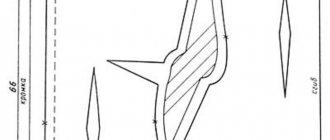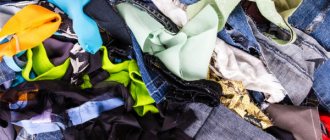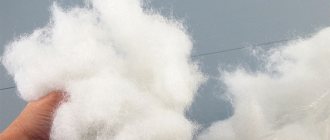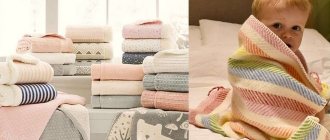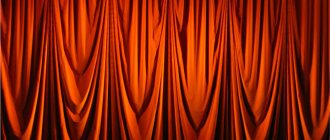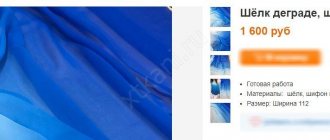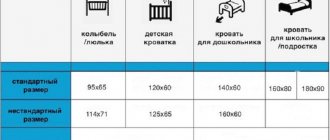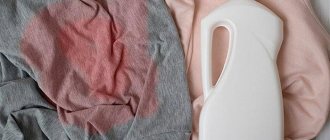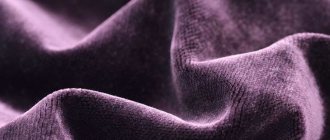Summer requires appropriate clothing and suitable fabric. Lightweight, comfortable materials will protect against overheating and skin irritation, and will not hinder movement. Preference is given to hygroscopic and antibacterial fabrics that absorb moisture, dry quickly and allow air to pass through the fibers well. Due to the summer heat, clothes often need to be washed, so you need to choose easy-to-care materials that retain their attractive appearance after numerous washes.
Natural raw materials for fabric
To create a comfortable summer wardrobe, not only the type of fabric is important, but also its composition. Natural fibers are considered the most suitable option for hot weather because they almost always absorb moisture well and “breathe”.
- Hemp is almost as ancient a raw material for clothing as silk. In Russia, hemp began to be grown during the reign of Peter the Great, and the resulting material was called hemp. In modern times, a variety of hemp that does not contain narcotic drugs is cultivated to make fabric. Hemp fabrics are very durable, wear-resistant and hypoallergenic. They absorb moisture well, do not accumulate static electricity, and also hardly wrinkle. Hemp is soft and light to the touch and retains color well.
- Linen fabrics were made back in the Neolithic era, also in Ancient Egypt. In modern times, flax is harvested by a combine, the straw is soaked, dried, washed and woven, and then spun into yarn. The fabric is environmentally friendly and conducts heat well. Linen is durable, does not electrify, is breathable and contains silica, which does not allow the development of bacteria and microorganisms.
- Ramie is a plant fiber obtained from Chinese nettle. Even with prolonged contact with water, this fabric does not rot. The material is soft, comfortable, breathable. Summer pants and shorts are made from ramie, and fibers are added to other fabrics.
- Cotton is harvested from the fields using special combines, and there are also small family businesses where the soft fibers are still harvested by hand. Cotton fabrics fit very nicely to the body, “breathe”, absorb moisture, but at the same time they are not at all elastic, wrinkle, dry slowly and do not last long. However, cotton is considered a universal material for hot weather.
- Silk is a protein fiber obtained from the cocoons of silkworms. The technology for making silk thread and fabric was invented in China more than five thousand years ago. Natural silk is a hygroscopic, durable and shape-stable material with a soft shine.
- Wool is obtained from the hair of furry animals (goats, sheep, llamas, camels), which are shorn, and yarn is made from the resulting raw materials. Wool is a very warm and hygroscopic material; only the finest fibers are used for sewing summer fabrics. Wool threads are used, for example, to create lightweight georgette fabric.
Types of summer clothes made from natural fabrics:
- dresses, sundresses, tunics;
- blouses and shirts;
- overalls;
- home clothes (robes, shirts);
- T-shirts, tank tops, tops;
- trousers and shorts;
- headwear (caps, Panama hats);
- shoes (moccasins, sneakers, elements of flip-flops and sandals);
- lightweight beach bags.
Synthetic threads can be found in many modern fabrics. Don’t be scared right away and give up the thing you like. It is synthetic fibers that reduce the cost of the product and also improve its characteristics. For example, cotton fabric with a small addition of synthetics will not wrinkle, and elastic lycra will allow the item to fit perfectly. However, people with sensitive skin and allergy sufferers should avoid synthetic materials.
Hygienic requirements for children's clothing and shoes
20.08.2019 16:25
Clothing and shoes are used to protect the body from cold, excessive solar radiation, wind, rain, snow; they protect the skin from mechanical and chemical damage, protect the body surface from dust, dirt and microorganisms. Clothing also plays an important role in the aesthetic education of children and adolescents.
Clothes for children are especially important because... The growing body of a child, due to imperfections in the functions of the central nervous system, is more susceptible to the influence of unfavorable environmental conditions. Thermal regulation in children is not yet perfect enough, so children can easily become hypothermic in cold, windy or damp weather, or overheat in summer, in hot weather. There are 3 layers in clothing: underwear, dress (or suit) and outerwear for the street.
Sweat, sebum secreted through the skin, as well as horny scales gradually peeling off from the surface of the skin are absorbed and deposited on the underwear. The underwear should be soft, absorb sweat well and evaporate it quickly, easily conduct air and water vapor. The most suitable fabrics for schoolchildren's underwear are: cotton, linen and rayon. Currently produced synthetic fabrics for children's underwear are not recommended, because... they are significantly inferior to fabrics made from natural fibers in their hygienic properties. High thermal conductivity, low hygroscopicity, and vapor permeability cannot ensure the removal of moisture from the skin, which increases the feeling of heat in warm weather and the feeling of cold in winter and promotes the proliferation of microorganisms on the skin.
The second layer of clothing, dresses, suits, serves mainly to protect against the cold. The main requirements are low thermal conductivity, convenience, durability and cleanliness. Clothing must correspond to the student’s height, be loose and not restrict his movements. Tight clothing, especially with tight elastic bands or ties, compresses blood vessels, making breathing and the functioning of internal organs difficult. Clothes that are too large and have very long sleeves also impede the movement of children. The best materials for dresses and suits are woolen and half-woolen fabrics, flannelette, and cotton wool. These fabrics are porous, they retain a lot of air, and clothes made from them are quite warm. Children's summer clothing should reflect the sun's rays and also promote the evaporation of the greatest amount of sweat, because... At high air temperatures, only the evaporation of sweat protects the body from overheating. The cut of summer clothing should ensure maximum access to the skin of fresh air and UV rays. It is advisable to sew clothes for summer from linen fabrics, which absorb sweat better than others, and from fabrics that transmit UV rays to the greatest extent, for example, acetate silk.
Outerwear (coats, fur coats) must be appropriate for height, light and warm. The synthetic material foam has the highest heat-shielding properties. It is elastic, porous, and clothing made from foam rubber combined with textile fabric is light and very warm. Excessively warm clothes are harmful for children. A child dressed in this way has some kind of warming compress on his neck. It is difficult for him to breathe, it is even more difficult for him to move, after a walk he finds himself sweaty and hot. A child who is accustomed to being wrapped up can catch a cold from the slightest wind, and his throat often hurts. Wrapping up a child means disarming his body in the fight against cooling. Children should be dressed according to the season and weather in such a way that they do not freeze, but also do not sweat during a walk.
The desire of some teenagers to go without hats in winter is also undesirable. In harsh winter conditions, every person needs a warm hat. During the cold seasons of the year, it is necessary to constantly monitor and strictly demand that schoolchildren wear hats when going outside. Staying outside in cold weather with your head uncovered leads to a cooling of the head, to a narrowing of the blood vessels of the brain, as a result of which the body's resistance decreases and the risk of diseases such as inflammation of the meninges, inflammation of the frontal sinuses, etc. increases.
The main requirement for shoes is that they correspond to the student’s foot size. Tight shoes, squeezing blood vessels, cause discomfort when walking. Constantly wearing tight shoes contributes to the growth of bunions, which disfigure the foot for life. But you should not wear shoes that are too loose: they are uncomfortable, they gradually lower the arch of the foot, weaken the muscles and ligaments, and cause flat feet.
The heel of children's shoes should be wide, no more than 1.5 - 2 cm high. Girls aged 14-16 years are not recommended to wear high-heeled shoes. This leads to instability of gait and increases the pressure of organs on the pelvic bones, and the pelvis in girls of this age consists of several bones that are not yet firmly fused to each other. A girl can wear high-heeled shoes for the first time no earlier than 17-18 years old (and even then not every day). It is necessary from a very early age to teach children to take care of their clothes and shoes, and to educate them to handle their clothes with care and precision.
Batiste
The fabric can be plain, patterned, or bleached.
Translucent, delicate and thin material made of cotton or linen. The weave of the threads is plain. The canvas can be smooth, as well as with patterns and ornaments. To make cambric, thin twisted yarn is used. The fabric can be plain, patterned, bleached and mercerized (special treatment to prevent fading). The most expensive and high-quality cambric is made from the finest hand-spun linen threads.
Fabric characteristics:
- environmental friendliness;
- hypoallergenic;
- ease;
- dimensional stability;
- ease of care;
- the fabric does not fade;
- does not wrinkle.
Nightgowns, blouses and dresses, as well as accessories (gloves and belts) are made from cambric. To maintain the aesthetic appearance of the product for as long as possible, it must be properly cared for. Both hand and machine washable in delicate mode. Wring out the products by hand and dry in the shade. If necessary, cambric is ironed through gauze.
Viscose
A very interesting fabric that is made from... trees. More precisely, from wood cellulose, which is crushed, split and treated with a special solution. Then strong threads are formed. Viscose is not a synthetic or natural fabric, it is artificial, that is, simply processed from natural materials.
Positive properties of viscose:
- drapeability;
- aesthetic soft shine of the surface;
- hygroscopicity;
- the fabric allows air to pass through well;
- not electrified.
Viscose becomes brittle when wet, so it is often reinforced with additional fibers. T-shirts, skirts, dresses and sundresses are made from this fabric. Things made of viscose are washed by hand or in a machine, using a delicate cycle. You should also choose mild detergents. Viscose is ironed through a soft fabric.
Coton, he is also a Coton in Africa
Beloved by everyone and the most democratic, it is revered by people of all ages, children and adults, elegant ladies and teenagers. Jeans, T-shirts, sundresses - our favorite summer clothes are mostly made of cotton. Cotton is a plant (cellulose) fiber obtained from cotton bolls. The quality of the fiber very much depends on the variety of this plant, its growing conditions, and agricultural technology. The best cotton grows in hot countries - Egypt, India; it produces very long fibers, from which the finest and highest quality fabric can be obtained.
pros
| Interesting | |
| Cotton is not resistant to acids and concentrated alkalis. The process of mercerization, that is, “refining” cotton to give it a silky shine, fineness, increase hygroscopicity and strength, and improve coloring, is based on this property. | |
Hygroscopic.
The body in cotton clothes breathes.
Durable, but slightly inferior to linen - can be washed many times.
It dyes well, allowing you to obtain countless colors and shades.
Depending on the thickness of the cotton fiber, you can produce the finest fabrics (chiffon, cambric, voile, voile, blouse, shirt fabrics) and denser ones, such as denim, for example.
Minuses
It wrinkles a lot, but modern fashion has turned this disadvantage into an advantage.
Guipure
Airy lace fabric with ornamental inserts that connect the patterns. Guipure was invented in Italy; in the 16th century it was ordered from Venetian craftsmen. The material is quite hard, but looks elegant. Suitable for decorating dresses and blouses; if there is little mesh and the fabric is almost opaque, it can be used independently.
Guipure is made from silk, cotton, linen, viscose threads, Lurex is added for decoration, lycra and polyester are added for elasticity.
Advantages of the material:
- practicality;
- dimensional stability;
- ease;
- aesthetic appearance;
- ease of care.
The more lace there is on the guipure fabric, the thicker and stiffer the fabric will be. The material should be protected from tightening and tearing. Despite the external fragility of the fabric, guipure can be washed both by hand and in a machine. Suitable water temperature is 30 degrees, iron temperature when ironing is 150 degrees.
Georgette
The fabric retains its shape well and emphasizes the figure.
Light and delicate, slightly grained fabric made from wool, viscose or silk. Polyester and elastane are also added to the composition. Twisted georgette threads are joined together in a strong plain weave. The texture of the material is quite rigid and retains its shape well, emphasizing the figure.
Fabric Features:
- hygiene;
- hygroscopicity;
- ease;
- wrinkles a little.
Draped dresses, blouses and skirts are made from georgette. The material is also used as finishing. It is recommended to wash georgette by hand using liquid detergent. Before drying, the product is carefully straightened. Iron georgette only from the inside out, preferably through a damp cloth.
Fabric for a summer dress - cocktail style
The requirements for a weekend outfit are simple: no rules. Geometric and floral prints, A-line and whimsical bell sleeves. For those who like to always be the center of attention, bright and rich shades are suitable: aquamarine, orange, bright yellow, fuchsia. But the main thing is that the fabric for a summer dress should reflect individuality and emphasize the beauty of the owner.
Dress linen fabric
Natural dress linen with a stylish print is an excellent choice for a festive outfit. Lightweight and breathable fabric allows you to move comfortably and protects you from direct sunlight on a hot day. Linen fabric for a summer dress will provide you with a stylish look! Advantages:
- Breathable outfit
- Original image
Flaws:
- High price
- Wrinkleability, processing
Fabric staple
The combination of natural and artificial fiber gives the material good characteristics: wear resistance, elasticity, softness, hygiene. A printed staple is a bright and gentle response to the summer heat and an attention-grabbing flirty look. Advantages:
- Lightness, permeability
- Favorable cost
Flaws:
- Shrinks when washed
- Doesn't like iron
Double crepe fabric
Double crepe and its crash variety are well suited for sewing formal cocktail dresses that emphasize the figure. Short dresses with a boat neckline and an open shoulder look great in this material. The crepe drapes in a large fold and has a dense texture. Advantages:
- Fits your figure
- Favorable cost
Flaws:
- Synthetic composition
- Requires delicate care
Satin
Smooth fabric with a silky surface. The weave of the threads is satin. Natural silk and cotton are used to make the material. Due to its elegant appearance, satin is often confused with satin, but the weave of these fabrics is different. There is a variety called jacquard satin - a double-sided material with a large woven pattern.
Fabric Features:
- hygroscopicity and breathability;
- smoothness;
- does not wrinkle;
- pleasant and cool to the touch.
Dresses and blouses are made from satin, and shoes are also covered with this material. To protect the front side of the fabric from puffs, the products are turned inside out. Permissible water temperature is 40-60 degrees. Satin practically does not wrinkle and does not require ironing.
Chintz
Men's and women's summer clothing is made from chintz.
Lightweight plain weave cotton fabric made only from natural fibers. It can be plain or with a pattern. The variegated, brightly colored fabric was invented centuries ago in India. Typically, chintz is made from calico, an untreated plain weave cotton.
Fabric characteristics:
- environmental friendliness;
- color fastness;
- ease of care and safety;
- breathability;
- hygroscopicity;
- affordable price.
Men's and women's summer clothes (dresses, blouses, shirts), as well as household items (robes and shirts) are made from chintz. Due to its 100% natural composition, chintz is not wear-resistant. When purchasing, you need to pay attention to the quality so that the paint does not fade in the future. Chintz also wrinkles a lot.
Before first use, it is recommended to wash the fabric in cold water - this softens the material and protects the paint. The permissible washing temperature is 50 degrees, items must be turned inside out first. To facilitate the ironing process, the fabric is sprayed with water.
Tulle
Lightweight mesh fabric of French origin. Made from cotton with the addition of polyester and silk. The canvas is decorated with a pattern, which is made on special tulle machines. The material is painted and decorated with lurex and rhinestones.
Fabric Features:
- ease;
- transparency;
- breathability;
- aesthetic beauty.
Tulle is used to decorate women's dresses, blouses and skirts; most often the fabric is used as a decoration for smooth and opaque materials. Caring for the products is very simple. The tulle is soaked in soapy water and then washed by hand. The fabric dries very quickly and does not need to be ironed. Tulle is protected from exposure to high temperatures so that the product does not deform.
Synthetic fibers
Such fabrics are created by the synthesis of simple substances obtained from natural and petroleum gases, oil and coal tar. Types of synthetic fibers:
- polyester
- polyamide
- polyvinyl chloride
- polyacrylonitrile
Polyamide includes nylon and anide, which are widely used today in the production of clothing for men and women. They sew from them:
- dresses
- blouses for women
- decorative furs
- socks
- raincoats for men and women, stockings and tights
Polyamide fabrics are characterized by high strength and the ability to stretch and contract, which is called elasticity. If you add 15% nylon to viscose, then this item of clothing will “wear off” 2-4 times slower. Clothing made from polyamide fibers weighs less when compared to clothing made from artificial fabrics.
Kapron is characterized by the following indicators:
- high heat conductivity
- low hygroscopicity
- low resistance to sunlight
- low temperature resistance
Therefore, nylon is not very useful for adults, and even more so for children. Wearing nylon affects the activity of the sebaceous and sweat glands, so irritation may appear on the skin. Due to high thermal conductivity, body hypothermia can occur. If you wear nylon products in winter, your feet may get frostbite. If you have skin diseases, it is better to avoid wearing nylon.
Polyester fibers are primarily laxan. In Canada and Britain it is known as terylene, and in the States it is called dacron. Externally, this material resembles fine wool. Its heat-protective properties are almost the same as those of wool, but its strength is 3 times higher. Also, polyester fiber lavsan is characterized by the following properties:
- crease resistance
- elasticity
- chemical stability
- thermal stability
- sun resistance
- abrasion resistance
- resistance to chemicals and even bacteria
- low hygroscopicity
- low water capacity
- low electrification
- high air and vapor permeability
Since the hygroscopicity of this fabric is very low, underwear cannot be made from it. But it can be added to fabric for sewing suits and dresses.
Nitron is known among polyacrylonitrile fibers in our country. In Germany it is called prelan. Like the material described above, it resembles wool fiber in appearance. Nitron is characterized by the following properties:
- resistance to bacteria
- softness
- looseness
- elasticity
- low creasing, etc.
Nitron is relevant for sewing suits, knitwear, faux fur and even bed linen. Polyacrylonitrile also has a number of disadvantages. It has low hygroscopicity, high hydrophobicity, and relatively low strength.
Polyvinyl chloride fibers are used for the production of clothing and footwear. Widespread of this group are PVC fiber and chlorine. Chlorine fiber normally tolerates high temperatures, exposure to light, and contact with chemicals. One of the disadvantages is low strength. These fibers are used to create fabrics for sewing coats and dresses, and are also added to knitwear.
When PVC fibers rub against the skin and each other, it causes a build-up of static electricity. This has a negative effect on the body. Clothing made from this material is often treated with antistatic agents.
Fatin
Most often, fluffy, wrinkle-resistant skirts are made from mesh.
Lightweight and stiff mesh fabric, most often made from synthetic nylon, polyester, elastane, and also viscose. Belongs to a special group of fabrics called mesh. The main feature of the material is the large gap between the weft and warp threads, forming a cell.
In appearance, tulle can be shiny or matte; the fabric is decorated with rhinestones, metallic sequins, embroidery, various coatings, and is also dyed in various colors.
Positive properties of tulle:
- elasticity and dimensional stability;
- wear resistance and strength;
- does not absorb moisture and dirt;
- dries quickly;
- allows air to pass through well.
Tulle is rarely used on its own because it is very harsh and can irritate the skin. Most often, petticoats and fluffy, wrinkle-resistant skirts are made from mesh. The tulle is washed by hand so that the drum of the washing machine does not damage the structure of the fabric, then rinsed well. The material does not wrinkle, but if persistent creases have formed, the tulle is treated with steam.
Natural silk and chiffon
In addition to cotton and linen fabrics, this season designers are offering their favorite light silk and airy chiffon. In the summer heat, weightless, beautiful outfits made of translucent thin fabrics look wonderful and feminine. And most importantly, they are comfortable and easy.
Natural silk absorbs moisture well, “breathes”, and dries the skin. This is ideal for those who suffer from excessive sweating. The material does not shrink, does not stretch, and drapes easily. Elegant dresses of various models and styles made of delicate flowing material are especially feminine.
Italian silk is one of the elite fabrics. It is characterized by high density, lightness, and hygroscopicity. Uzbek silk, which is produced in a unique way and dyed only with natural dyes, is also highly valued. High quality silk comes from China, which leads the world in the production of this fabric.
Just like summer dresses made of silk, airy, light chiffon dresses never go out of style. The material, although thin, is dense. It colors well and drapes well. Light sundresses and loose dresses made of chiffon on a cotton or silk base are comfortable in summer. In addition, such clothes are easy to care for.
Various models are relevant: mini and maxi, with high slits, deep necklines, complex or simple cut, decorated with frills, draperies, ruffles, flounces, short sleeves, beads, bows, with delicate floral patterns.
Chambray
Chambray, or chambry, is one of the types of denim fabrics. The material was invented in France in the 16th century. This is a soft, lightweight fabric, reminiscent of cambric in its structure. Chambray is made from cotton using a twill weave. The finished fabric has a fine diagonal ribbed pattern.
Advantages of chambray:
- lightness and density;
- wear resistance;
- hygroscopicity;
- breathability;
- not electrified;
- does not allow dust to pass through.
Due to its natural composition, chambray wears and fades over time, dries slowly and shrinks after washing. Comfortable summer trousers, shorts, dresses and shirts are made from chambray. The fabric withstands both machine and hand washing and practically does not wrinkle. The permissible water temperature when washing is 40 degrees.
